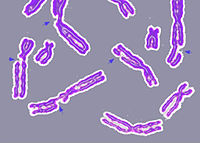
Photo from wikipedia
A flurry of papers has appeared recently to force a rethinking of our understanding of how chemicals, light, and metal complexes damage our genomes. Conventional wisdom was that damaging agents… Click to show full abstract
A flurry of papers has appeared recently to force a rethinking of our understanding of how chemicals, light, and metal complexes damage our genomes. Conventional wisdom was that damaging agents were indiscriminate and it was statistical bad luck, coupled with evolutionary selection, that drove mutational signatures after exposure of DNA to damaging agents. Recent data, however, suggests that primary DNA damage itself does not drive mutational signatures; instead, it is the selectivity of repair pathways on different regions of the genome that is decisive. In particular, genomic regions shielded by transcription factors or packed densely in nucleosomes are poorly repaired by nucleotide excision repair and are far more susceptible to mutation. There are plenty of approved therapies, the mode‐of‐action of which is to alkylate DNA, and although historically efforts have been focused on understanding how chemicals modify DNA, these new findings suggest that focus should be shifted to understanding genome‐wide repair specificities when different types of alkylation damage occur.
Journal Title: ChemBioChem
Year Published: 2017
Link to full text (if available)
Share on Social Media: Sign Up to like & get
recommendations!